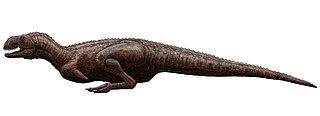
Indosuchus is a genus of abelisaurid dinosaur from the Late Cretaceous Period, a theropod related to Abelisaurus. Like most theropods, Indosuchus was a bipedal carnivore. It was about 7 metres long, weighed about 1.2 tonnes, and had a crested skull, flattened on the top.

Minmi is a genus of small herbivorous ankylosaurian dinosaur that lived during the early Cretaceous Period of Australia, about 120 to 112 million years ago.

Shunosaurus, meaning "Lizard from Sichuan", is a genus of sauropod dinosaur from Late Jurassic (Oxfordian) beds in Sichuan Province in China, from 161 to 157 Million years ago. The name derives from "Shu", an ancient name for the Sichuan province.
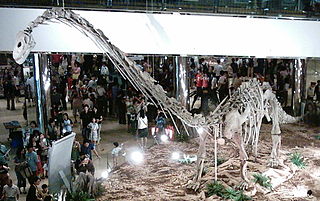
Omeisaurus is a genus of sauropod dinosaur from the Middle Jurassic Period of what is now China. Its name comes from Mount Emei, where it was discovered in the lower Shaximiao Formation of Sichuan Province.

Maxakalisaurus is a genus of titanosaur dinosaur, found in the Adamantina Formation of Brazil, in the state of Minas Gerais in 1998. The genus name is derived from the tribe of the Maxakali; Topa is one of their divinities.

The Princeton Battlefield in Princeton, Mercer County, New Jersey, United States, is where American and British troops fought each other on January 3, 1777, in the Battle of Princeton during the American Revolutionary War. The battle ended when the British soldiers in Nassau Hall surrendered. This success, following those at the Battle of Trenton on December 26, 1776, and the Battle of the Assunpink Creek the day before, helped improve American morale.

Cimoliasaurus was a plesiosaur that lived during the Late Cretaceous (Maastrichtian) of New Jersey. It grew up to 7.5 metres (25 ft) long and weighed up to 1 metric ton.

Tricleidus is an extinct genus of cryptoclidid plesiosaur known from only specimen from the middle Jurassic of United Kingdom. It was first named by Andrews in 1909 and the type species is Tricleidus seeleyi. It was a relatively medium-sized plesiosaur, measuring 5 metres (16 ft) long and weighing 700 kilograms (1,500 lb).
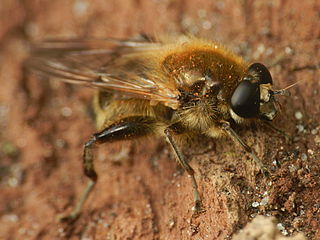
Brachypalpus is a genus of hoverflies, from the family Syrphidae, in the order Diptera. The head is triangular and produced well forwards and somewhat downwards. The thorax and abdomen with pile often rather long. The hind femur is swollen and with an obtuse spur apically and ventrally. The hind trochanters of male is spurred.
The larvae are of the rat-tailed type feeding on decaying sap under tree bark. Larvae live in decaying trees and logs. Larva and pupa have been described by Malloch.

Tropidia is a genus hoverflies, from the family Syrphidae, in the order Diptera.

Pterallastes is a genus of bee-mimicking hoverflies. So far the genus contains only two species, one in North America and one from the Sichuan province of China.

Teuchocnemus is a genus of North American flower flies.
Chalcosyrphus (Xylotomima) anthreas, the Yellow-banded Leafwalker, is a rare species of syrphid fly found in eastern North America. Hoverflies can remain nearly motionless in flight. The adults are also known as flower flies for they are commonly found on flowers, from which they get both energy-giving nectar and protein-rich pollen.
Hadromyia aepalius, the Sterling Quicksilver, is a rare species of syrphid fly found in eastern North America. Hoverflies get their names from the ability to remain nearly motionless while in flight. The adults are also known as flower flies for they are commonly found around and on flowers, from which they get both energy-giving nectar and protein-rich pollen.
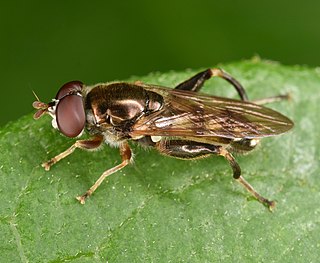
Chalcosyrphus (Xylotomima) metallicus, the Yellow-legged Leafwalker, is an uncommon species of syrphid fly observed in the southeastern United States. Hoverflies are able to remain nearly motionless while in flight. The adults are also known as flower flies for they are commonly found around and on flowers, from which they get both energy-giving nectar and protein-rich pollen.

Spilomyia alcimus, the Broad-banded Hornet Fly, is an uncommon species of syrphid fly first officially described by Walker in 1849. Hoverflies get their names from the ability to remain nearly motionless while in flight. The adults are also known as flower flies for they are commonly found around and on flowers, from which they get both energy-giving nectar and protein-rich pollen. The larvae are known as the short-tailed larvae suited for moist areas such as rot holes of trees.
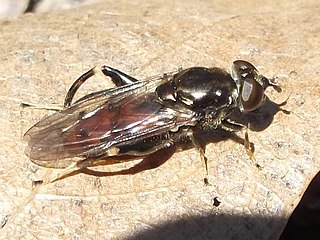
Chalcosyrphus (Xylotomima) libo, the Long-haired Leafwalker, is an uncommon species of syrphid fly observed in north-central North America. Hoverflies are able to remain nearly motionless in flight. The adults are also known as flower flies for they are commonly found around and on flowers, from which they get both energy-giving nectar and protein-rich pollen.

Chalcosyrphus (Xylotomima) piger, the short-haired leafwalker, is an uncommon species of syrphid fly found throughout North America and Europe. Hoverflies get their names from the ability to remain nearly motionless while in flight. The adults are also known as flower flies, for they are commonly found around and on flowers, from which they get both energy-giving nectar and protein-rich pollen. Larvae have been identified from sappy hollows from Larix and Pinus.
Brachypalpus amithaon is a species of hoverfly in the family Syrphidae.
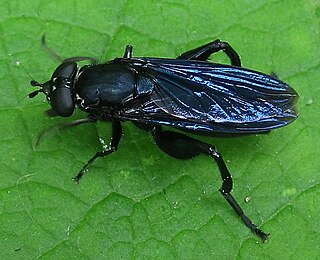
Chalcosyrphus (Xylotomima) chalybeus , the Violet Leafwalker, is a fairly common species of syrphid fly observed in the Northeastern United States. Hoverflies can remain nearly motionless in flight. The adults are also known as flower flies for they are commonly found on flowers, from which they get both energy-giving nectar and protein-rich pollen.
















